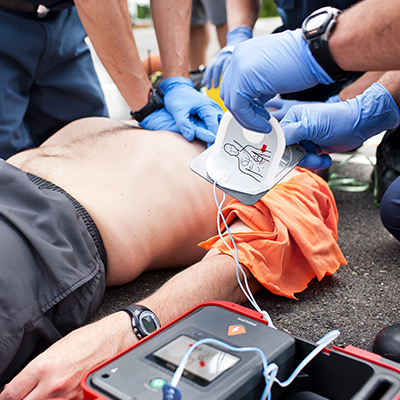350,000 Americans die every year due to Sudden Cardiac Arrest. But, when first responders have the best equipment, every victim can have a fighting chance.
Penn Care proudly offers the Philips HeartStart FR3, an automated external defibrillator that is intended for use with a physician’s oversight as part of a comprehensive emergency response plan. The FR3 has numerous design features that minimize deployment time and maximize life saving potential for emergency medical services (EMS). Its SMART biphasic waveform technology can assess heart rhythm activity in a wide variety of patients.
Responders should be specifically trained in the operation of the Philips HeartStart FR3 as well as in Basic Life Support, Advanced Life Support, or a similar medical response program. This blog is meant for informational purposes only, and is a short overview of the Philips HeartStart FR3’s capabilities.
Initial Setup of Philips HeartStart FR3
To perform the initial setup of the HeartStart FR3, first, check the contents of the FR3’s box and verify that it contains the following items: the HeartStart FR3 AED, one FR3 primary battery, one set of SMART pads III (electrode pads), one Guide to Setup, Operations, and Maintenance, and one Administrator’s Reference CD-ROM. The Guide to Setup, Operations, and Maintenance provides directions for use of the FR3 with default settings. The language card can be used to change the primary language of the FR3 (which should only be performed under the supervision of the Medical Director).
To install the battery, check the battery label to ensure that the battery is within its install-by date. Remove the battery from its packaging and install it in the battery compartment located on the back of the FR3. Make sure that both of the battery’s latches click into place. As soon as the battery is installed for the first time, the FR3 will begin a user initiated diagnostic test. Press each button on the FR3 when directed by the unit to do so.
After the battery installation and initial test, you will need to set the date and time. The date format is the four-digit year, followed by the name of the month, then the two digit day. The FR3 uses a 24 hour clock and displays two digits each for the hour, minute, and second.
Following the initial test, the FR3 will display a “clock not set” message. Press the “Administration” button to go to the administration screen. When on the administration screen, press the “Down” option button to scroll to “Setup”, then press the “check mark” option to select it. On the setup screen, press the “Down” option button to scroll to “Date and Time”, then press the “checkmark” option to select it.
On the date and time screen, press the “Down” option to stop the automatic time incrementing and display the “Change date and time” screen. After entering the correct time, date, and year, press the “check mark” option to exit the screen. Then press the “On/Off” button to display the status screen and allow the FR3 to enter standby mode. The green “Ready” light should be flashing, indicating that the FR3 is ready for use.
The FR3 should reside in an accessible area, where the green “Ready” light can easily be seen. Philips recommends that the FR3 and pads be secured in a protective carry case, such as the optional FR3 carry case. The device performs detailed daily, weekly and monthly self-tests to check its readiness for use.
Using the HeartStart FR3 AED
These instructions are based on the factory default settings for the HeartStart FR3. Remember, this blog is for informational purposes and is not meant to replace a training course.
A person suffering from sudden cardiac arrest will not be breathing normally, and will not respond when touched or shaken. To use the HeartStart FR3, first turn on the device by pressing the green “on/off” button. If the FR3 is stored in the FR3 carry case, it will automatically turn on when the case is opened. Voice prompts from the FR3 will direct the user in all steps of the process, but users familiar with the FR3 do not have to wait for prompts to place pads. The FR3 will sense pad placement and move onto the next appropriate prompt.
Step One: Open Carrying Case and Begin Pad Placement
Remove all clothing from the victim’s upper body. Wipe away any excess moisture from the patient’s skin, and clip or shave any chest hair so the pads can make good contact.
*Pay close attention to any lumps or surgical scars on the victim’s chest, as these could be indicators of an implanted defibrillator or pacemaker. Avoid placing the pads over these areas.
Step 2: AED Analysis and Shock Delivery
The FR3 will begin analysis of the victim’s heart rhythm as soon as the pads are attached. Do not touch the victim while the analysis is taking place. If no shock is advised, the FR3 will prompt an “attend to patient” period.
If a shock is advised, the FR3 will begin charging to prepare for a shock delivery. While the FR3 charges, make sure nobody is touching the victim or the pads. The unit will continue to analyze the victim’s heart rhythm, and if the rhythm changes and a shock is no longer needed, the FR3 will disarm and voice prompts will advise the next appropriate action.
The FR3 will alert the user that it is ready to deliver a shock in four ways:
- A voice prompt that tells the user to deliver the shock
- An orange “shock” button will be flashing
- An on-screen text prompt telling the user to press the “shock” button
- A steady tone from the FR3.
Again, make sure nobody is touching the victim, and press the “Shock” button to deliver a shock to the victim. A voice prompt will confirm delivery of the shock.
Step 3: Conduct CPR Chest Compressions
Once shocks have been delivered, the FR3 will begin its pre-configured smart CPR protocol. Perform chest compressions for the entire duration of the CPR protocol, until you hear a voice prompt form the FR3 instructing you to stop. The device will then conduct a heart rhythm analysis.
Philips’ Quick Shock feature typically delivers shock therapy in as little as eight seconds after chest compressions, reducing CPR interruptions. You should not touch or move the victim while the analysis is taking place.
Using The HeartStart FR3 on an Infant or Pediatric Victim
For treatment of an infant or pediatric victim, first begin CPR while an available person calls emergency services. If nobody else is available, perform CPR for one to two minutes before retrieving the HeartStart FR3, unless you witnessed the child’s collapse.
If you have the optional infant/child key, and the victim is under 55 lbs or 8 years of age, then insert the key firmly into the port located at the upper right corner on the front of the device. Turn on the FR3 and then remove all clothing from the child’s torso, as the pads will be placed on the child’s chest and back. Place one pad on the center of the chest between the nipples and the other in the center of the back as directed in the HeartStart FR3 manual. The pads are interchangeable, so it does not matter which pad is on the chest and which is on the back.
The FR3 will announce “Infant/Child Mode” when the infant/child key is inserted and will provide directions on how to place the pads. The unit will automatically reduce the shock level to an amount better suited for treating infants and children. Infant/child CPR protocol will also be initiated.
There are certain situations where the HeartStart FR3, or any automated external defibrillator, should never be used. If the victim is in water or excessively sweaty, the device should not be used. It should never be operated around oxygen containers or other combustible materials, and you should never attempt to use the HeartStart FR3 on yourself.
Philips HeartStart FR3: The Professionals’ Choice
Philips has designed the HeartStart FR3 AED specifically for first responders with Basic or Advanced Life Support training. It is meant to be simple, easy to operate, and dependable.
No manual calibration of the device is required. As long as the green “ready” light is blinking, the device is ready for use.
After using the Philips HeartStart FR3 AED, check the outside of the unit for damage or dirt. Cleaning should be performed with a soft, damp cloth and soapy water. Ammonia-based cleaners can also be used, or a mixture of 2 tablespoons of chlorine bleach diluted in a quart of water. Make sure the battery is installed during cleaning of the FR3 so that liquids cannot enter the device.
Do not submerge the unit in any liquids or allow liquids to spill onto it. Sterilizing the Philips HeartStart FR3 or any of its components is not necessary.
Make sure to replace the SMART pads after use, and record their replacement in the maintenance log. The HeartStart FR3 can be stored without SMART pads attached. Do not store the HeartStart FR3 with the Infant/Child key inserted, because the infant/child level of defibrillation therapy will not be suitable for most adults. Leaving the key inserted will also cause the FR3 to fail its next regular self-test.
Next, remove the FR3’s battery pack to check the unit’s data card, if one is installed. Download the incident darta if your local protocol requires. The data card can hold up to eight hours of electrocardiogram (ECG) data, event data, Q-CPR data, and voice recording. Philips recommends that you replace the used FR3 data card with a new one after each use to eliminate the risk of lost data.
Caring for the Philips HeartStart FR3 AED
Periodic maintenance of the HeartStart FR3 is minimal but essential for the unit to be prepared to do its job. Be sure to check daily to ensure that the green “Ready” light is blinking. Check any spare accessories for damage, and replace any that are expired. Inspect the outer casing of the unit for cracks or damage. If damage is present, contact Philips technical support for assistance. All regular maintenance checks should be recorded in the inspection log.
It is recommended to have a spare battery and spare SMART pads with the HeartStart FR3, and these can be purchased separately. It is strongly recommended to purchase the Infant/Child key, especially if the device will be in a setting where children are present. Other suggested accessories include scissors for cutting through clothing, disposable gloves to protect the user, a disposable razor for removing chest hair if the pads cannot make good contact, a mask or face shield to protect the user, and a towel or wipes to dry the skin for good pad contact. These items are available in a Philips Fast Response Kit.
One of the Best Professional-Grade AED Machines Available
The Philips HeartStart FR3 is designed for professionals, with the input of professionals. It’s the smallest and lightest professional grade AED available today with a high resolution color LCD screen that provides guidance even in the harshest conditions and noisy environments. FR3 units shipped after December 1, 2011 come with an eight year warranty from the date of shipment. The non-rechargeable lithium battery has a four year warranty from the date of installation, as long as the battery is installed by its shelf life date. For more information about the Philips HeartStart FR3 AED, or other reliable Philips healthcare products, contact Penn Care, your trusted leader for emergency medical supplies and equipment.



